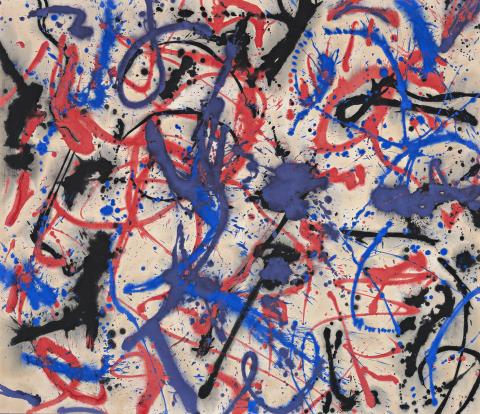UNTITLED, 1972
DICK WATKINS
synthetic polymer paint on canvas
142.5 x 165.0 cm
signed, dated and inscribed with title on stretcher verso: UNTITLED / 1972 / WATKINS
Yuill/Crowley, Sydney
The Collection of Colin and Elizabeth Laverty, Sydney, acquired from the above in July 1985
Australia – Dick Watkins, XVII Bienal de São Paulo, Brazil, 4 October – 15 December 1985, cat. 2 (illus. in exhibition catalogue) (label attached verso)
Dick Watkins: A Retrospective, Manly Art Gallery and Museum, Sydney, then touring to Broken Hill City Art Gallery, 13 March 1986
Paintings from the Laverty Collection, Union Club, Sydney, 26 November 2008 – 11 June 2009
‘The way I start a picture is purely intuitive. Each time I have a certain optimism that this will be the ideal painting, the masterpiece, and that is what I believe painting should try to do. It should be an attempt to make something beautiful and powerful at the same time. I think that what Pollock did is ideal. That’s how an Abstract picture should be painted.’1
The artist’s own words in a meaningful interview with Grazia Gunn in 19832 describe perfectly the complex dialogue between Watkins and the master of North American Abstract Expressionism, Jackson Pollock which is clearly exemplified in Untitled, 1972. This powerful abstract painting in landscape format, featuring gestural darts, arcs, drips and splatters in navy and royal blue, raspberry red and black applied directly on canvas without priming, was executed in the same manner used by Pollock, defined as ‘drip painting’ or ‘action painting’. Watkins would have worked on the unstretched canvas placed on the floor, using very fluid synthetic polymer paint and letting the colour drip from the brush in mid-air, even at times pouring the paint directly from the can and using his hands to spread it (a mark of the artist’s hand is clearly visible on the top centre section of the painting).
Self-taught, Watkins travelled to Europe, London and New York between 1959 and 1961, thus gaining first hand access to ground-breaking, seminal masterpieces of modernism and abstraction which played a key role in shaping his practice. Watkins himself has described his oeuvre as a product of Pablo Picasso and Jackson Pollock.3
Often been described as a ‘chameleon’ or ‘bricoleur’, his experimental style is a tribute to constant inquisition into other artists, styles and philosophies. Indeed, many of Watkins’ paintings suggest aspects of other artists’ work, but are ultimately entirely his own. As Imants Tillers points out in the essay accompanying the São Paulo Biennial catalogue, it is not a conscious attempt to emulate other artists’ work, it happens automatically. This kind of exact spontaneous correspondence is more like a synchronicity or coincidence of images with the original, and in many ways is a far more remarkable achievement than the original.4 Representing Australia in the São Paulo Biennial was validation of Watkins’ status as a prominent international artist.
Established in 1951, São Paulo is the second longest running biennale in the world after Venice (established in 1895). The 1985 retrospective exhibition was curated by Noela Yuill, who had a long professional association with Watkins, and witnessed the arrival and spread of ‘the new abstraction’ in Australia through her involvement with the Contemporary Art Society and the Central Street Gallery. Another highlight in Watkins’ career, spanning over five decades, was his inclusion in the ground-breaking 1968 exhibition The Field at the newly opened National Gallery of Victoria. There he was singled out by the influential American critic, Clement Greenberg, as Australia’s finest painter.5
In 1993, the artist was honoured with an exhibition at the National Gallery of Australia, where his work was hung alongside those of the European and American Masters who shaped his passion and oeuvre, among them Robert Rauschenberg and Ellsworth Kelly, as well as Matisse, Picasso and Pollock.
As curator Barbara Dowse remarked, ‘What emerged from that juxtaposition, is that irrespective of the sources implicated in his paintings, Watkins continues to pit himself against these mentors and rivals to wrest a mature style which is distinctively and recognisably his own.’6
1. Watkins, D., quoted in Gunn, G., ‘Dick Watkins’, Art and Australia, Sydney, vol. 21, no. 2, Summer 1983, p. 210
2. Gunn, G., op. cit., pp. 210 – 216
3. Ibid., p. 216
4. Tillers, I., ‘The Paradox of Dick Watkins’, in Dick Watkins, XVIII Bienal de São Paulo, Brazil, 4 October– 15 December 1985, The Broken Hill City Art Gallery, New South Wales, cat. 2, p. 21 (illus.)
5. Lumby, C., ‘Dick Watkins, An Artist’s Artist’, Australian Art Collector, Sydney, issue 31, January – March 2005, p. 137
6. Dowse, B., Dick Watkins, Liverpool Street Gallery, accessed online 18 February 2017 www.liverpoolstreetgallery.com.au
ELENA SCOTT
